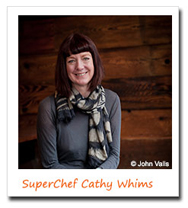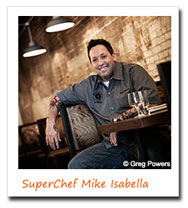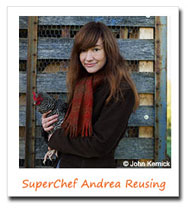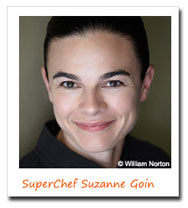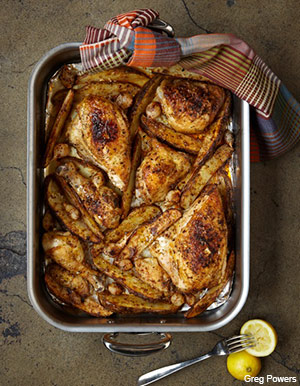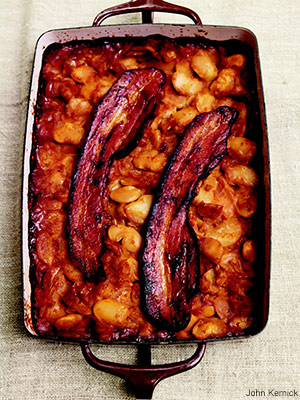Top Chef Recipes Feature Meat Raised Without Antibiotics
Antibiotics are widely overused in food animal production just to compensate for overcrowded and unsanitary conditions, a practice that breeds drug-resistant superbugs that can infect us. You can encourage industrial farms to stop these practices by cooking with meat and poultry raised without antibiotics. Learn more about Pew's collaboration with chefs.
Below are recipes provided by award-winning chefs who are calling for a stop to the meat industry's overuse of antibiotics in food animal production.
Executive chef of the popular Portland, Oregon restaurant Nostrana and four-time James Beard-Award nominee, Chef Cathy Whims is well known for her focus on local and sustainable ingredients.
Nostrana's Tagliata
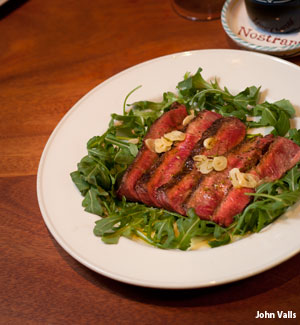 Serves 4–6
Serves 4–6
2 pounds flat iron steak, raised without antibiotics
6 cups arugula, trimmed, washed, and dried in a salad spinner, then kept chilled
½ cup extra virgin olive oil
10 cloves garlic, thinly sliced
2 sprigs rosemary
Salt and freshly ground black pepper
Prepare a grill, preferably using hard wood, mesquite, or, if necessary, gas.
Season flat irons generously with salt and pepper.
Warm olive oil in a small saucepan with garlic until garlic starts to just color.
Take off heat and add rosemary.
Grill meat to desired doneness, but for flat iron, rare to medium rare is optimal.
When done, transfer to a platter and let rest for 5 minutes.
Place arugula on a large platter.
Thinly slice steaks on the diagonal, about ⅓-inch thick.
Arrange meat over arugula, spoon over olive oil sauce (removing rosemary), and serve.
Rahman "Rock" Harper is director of kitchen operations at DC Central Kitchen, a non-profit organization that offers job training, meal distribution and local farm partnerships to help alleviate poverty, hunger and homelessness. Rock won the third season of the television show Hell's Kitchen.
Brined Fried Chicken
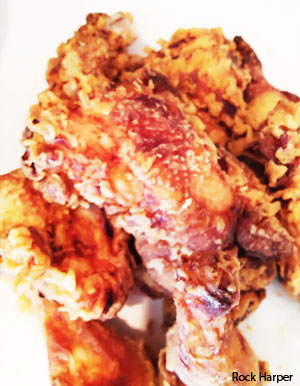 Use organic products if you are able to do so.
Use organic products if you are able to do so.
Fried chicken:
2 chickens raised without antibiotics, 3 pounds each, cut into 8 pieces each
2 tablespoons sea salt
2 cups flour
½ cup cornstarch
½ cup rice flour
1 ½ teaspoons paprika
3 teaspoons freshly ground black pepper
Peanut oil for deep frying
Brine:
1 quart water
¼ cup brown sugar
¼ cup sea salt
1 teaspoon black peppercorns
1 garlic clove, smashed
1 small onion, peeled and quartered
Brine:
Pour 4 cups cold water into a pot and bring to a boil over high heat.
Remove from the heat and add the brown sugar, salt, peppercorns, garlic and quartered onion. Allow to cool completely (40°F).
Fried chicken:
Put the chicken in a glass baking dish and pour the brine over the chicken. Cover with plastic wrap and refrigerate for 12-24 hours.
Remove the chicken from the brine and let it dry slightly on a wire rack while preparing the flour.
Pour the oil into a deep fryer or 5-quart pot and heat it to a temperature of 350°F.
In a large bowl, stir together the flour with the remaining salt and spices.
Dredge the chicken 4 pieces at a time in the flour. Gently shake the bowl to coat the chicken with flour, and then transfer the pieces to a wire rack, being careful not to scrape off the batter. Repeat with the remaining pieces of chicken and let dry on the wire rack for 30 minutes.
Cook the white and dark meat separately until they reach an internal temperature of 165°F (approximately 15 minutes white, 18 minutes dark). Cook only about 4-6 pieces per batch.
Overcrowding the oil will drop the temperature too much and yield a greasy product. Drain on paper towels and serve with plenty of napkins!
"Top Chef" alum Mike Isabella is chef and owner of Washington, DC-based restaurants Bandolero and Graffiato and has plans to open two more establishments in 2013. Chef Isabella was named Food & Wine's "The People's Best New Chef Mid-Atlantic" for 2012.
The following receipe is from Isabella's cookbook, Crazy Good Italian: Big Flavors, Small Plates, 2012, De Capo
Mom's Broiled Chicken with Potatoes and Onions
Some people roast their chicken, while others fry it. I like mine broiled — and once you prepare it this way, you're going to wonder why you ever made chicken any other way. You could buy a whole chicken and break it down yourself, or buy a chicken already cut into pieces — breast, legs, thighs, wings — and make it even easier. When my mom made chicken for my sister and me, this is how she did it. This dish always reminds me of home
Serves 4–6
Active Time = 20–25 minutes
Inactive Time = 25 minutes
3–3½-pound chicken raised without antibiotics cut into parts
1/3 cup extra virgin olive oil
2 tablespoons dried oregano
1 tablespoon minced garlic
1½ teaspoons smoked paprika
1 lemon, zested and then cut into wedges
1½ teaspoons plus 1½ teaspoons kosher salt
1½ teaspoons freshly cracked black pepper
2 medium-size russet potatoes, unpeeled, and cut into 12 wedges each
16 white pearl onions, peeled
1 teaspoon sea salt (prefer Maldon)
Preheat oven broiler on high and position oven rack in the middle of the oven (8 inches away from the broiler flame is ideal).
Remove chicken from refrigerator and let it rest at room temperature for a few minutes while completing the next step.
In a small mixing bowl, stir together the olive oil, oregano, garlic, paprika, and lemon zest until it forms a paste.
In a separate large mixing bowl, add the chicken pieces, half of the paste, and 1½ teaspoons salt. Use your hands to rub the paste evenly onto the chicken, then season with pepper, and arrange chicken parts skin-side-up in a large roasting pan.
In the same large mixing bowl, add potato wedges, onions, and remaining paste and salt. Toss to combine and arrange around the chicken pieces in the roasting pan, being careful not to overlap ingredients.
Place roasting pan under the broiler, close the oven door, and broil for 25 minutes.
Slowly open the door (BE CAREFUL — do not put your face near the oven door as the smoke and heat can be intense). Remove roasting pan from oven and check the temperature with a meat thermometer. The chicken is done when temperature registers 160°F and the juices run clear. Let the chicken rest at room temperature for 4–5 minutes before serving.
Arrange chicken on a large platter and place potatoes and onions around. Squeeze lemon wedges over dish and season with sea salt. Serve family style.
Andrea Reusing collaborates with local farms and fisheries to source her North Carolina-based restaurant, Lantern. Named one of "America's Top 50 Restaurants" and "best farm-to-table restaurant" by Gourmet Magazine, Lantern is a marriage of Asian flavors and North Carolina ingredients.
The following recipe is from Reusing's cookbook Cooking in the Moment: A Year of Season Recipes, 2011, Clarkson Potter.
Old-Fashioned Baked Beans with Smoked Bacon
Serves 6 as a side dish
¼ cup tomato paste
¼ cup sorghum
3 tablespoons dry mustard
2 tablespoons cider vinegar
1 tablespoon dark brown sugar
Kosher salt
1 cup dark beer
2 quarts cooked white beans, drained, cooking liquid reserved
6 thick slices smoked bacon (from pigs raised without antibiotics)
Preheat oven to 400°F.
In a medium bowl, combine the tomato paste, sorghum, dry mustard, vinegar, brown sugar, and 1 teaspoon salt. Slowly stir in the beer. Add the beans plus enough of their reserved cooking liquid to create a slightly soupy texture. Combine, and taste for salt, adding a bit more if necessary. Reserve the remaining bean cooking liquid. Transfer the mixture to a shallow baking dish and top with the bacon.
Bake for 30 to 40 minutes, until the bacon is golden brown and the beans are very hot, checking several times and adding a little more liquid or water if necessary so that the beans don't dry out; they should remain a bit saucy.
Suzanne Goin is a chef and restaurateur from Los Angeles, California. She received five concurrent nominations for Outstanding Chef of the Year by the James Beard Foundation from 2008-2011. "A great many cooks have come through the kitchen at Chez Panisse,” observes the legendary Alice Waters, “But Suzanne Goin was a stand-out."
The following recipes are from Suzanne Goin's cookbook Sunday Suppers at Lucques.
Braised Beef Short Ribs with Potato Purée, Swiss Chard, and Horseradish Cream
Download a PDF of these recipes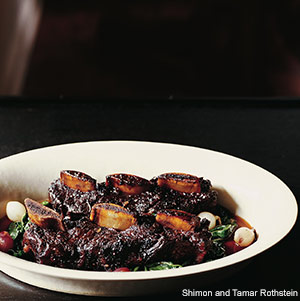
NOTE: Short ribs, like most braised dishes, taste even better the next day. Remember you will need to marinate them a day before braising.
6 beef short ribs raised without antibiotics, 14 to 16 ounces each (ask for 3 bone center-cut)
1 tablespoon plus 1 teaspoon thyme leaves, and 4 whole sprigs thyme
1 tablespoon freshly cracked black pepper
3 dozen small pearl onions
1/2 cup extra-virgin olive oil
1 cup diced onion
1/3 cup diced carrot
1/3 cup diced celery
2 bay leaves
2 tablespoons balsamic vinegar
1 cups port
2 cups hearty red wine
6 cups beef or veal stock
4 sprigs flat-leaf parsley
2 bunches Swiss chard, cleaned, center ribs removed
Kosher salt and freshly ground black pepper
Season the short ribs with 1 tablespoon thyme and the cracked black pepper.Use your hands to coat the meat well. Cover, and refrigerate overnight. Take the short ribs out of the refrigerator an hour before cooking, to come to room temperature. After 30 minutes, season them generously on all sides with salt. When you take the ribs out of the refrigerator, preheat the oven to 425°F.
Toss the pearl onions with 2 tablespoons olive oil, 1 teaspoon thyme, 3/4 teaspoon salt, and a pinch of pepper. Spread them on a baking sheet and roast them about 15 minutes, until tender. When they have cooled, slip off the skins with your fingers and set aside. Turn the oven down to 325°F.
When it's time to cook the short ribs, heat a large sauté pan over high heat for 3 minutes. Pour in 3 tablespoons olive oil, and wait a minute or two, until the pan is very hot and almost smoking. Place the short ribs in the pan, and sear until they are nicely browned on all three meaty sides. Depending on the size of your pan, you might have to sear the meat in batches. Do not crowd the meat or get lazy or rushed at this step; it will take at least 15 minutes. When the ribs are nicely browned, transfer them to a braising pan. They should lie flat, bones standing up, in one layer.
Turn the heat down to medium, and add the onion, carrot, celery, thyme sprigs, and bay leaves. Stir with a wooden spoon, scraping up all the crusty bits in the pan. Cook 6 to 8 minutes, until the vegetables just begin to caramelize. Add the balsamic vinegar, port, and red wine. Turn the heat up to high, and reduce the liquid by half. Add the stock and bring to a boil. Pour the liquid over the short ribs, scraping any vegetables that have fallen on the ribs back into the liquid. The stock mixture should almost cover the ribs. Tuck the parsley sprigs in and around the meat. Cover tightly with aluminum foil and a tight-fitting lid if you have one. Braise in the oven for about 3 hours.
To check the meat for doneness, remove the lid and foil, being careful of the escaping steam, and pierce a short rib with a paring knife. When the meat is done, it will yield easily to a knife. Taste a piece if you are not sure. Let the ribs rest 10 minutes in their juices, and then transfer them to a baking sheet. Turn the oven up to 400°F. Place the short ribs in the oven for 10 to 15 minutes, to brown. Strain the broth into a saucepan, pressing down on the vegetables with a ladle to extract all the juices. Skim the fat from the sauce and, if the broth seems thin, reduce it over medium-high heat to thicken slightly. Taste for seasoning.
Heat a large sauté pan over high heat for 2 minutes. Tear the Swiss chard into large pieces. Add 3 tablespoons olive oil to the pan, and stir in the cooked pearl onions. Add half the Swiss chard, and cook a minute or two, stirring the greens in the oil to help them wilt. Add a splash of water and the second half of the greens. Season with a heaping 1/4 teaspoon salt and a pinch of ground black pepper. Cook for a few more minutes, stirring frequently, until the greens are tender. Place the Swiss chard on a large warm platter, and arrange the short ribs on top. Spoon lots of braising juices over the ribs. Serve the hot potato purée and horseradish cream on the side.
Potato Purée
NOTE At the restaurant, we pass the mixture through a fine-mesh tamis [twice] using a rubber spatula. This makes an extremely smooth purée. You can skip this step if you want a more rustic-style potato purée. If you are going to serve the purée immediately, you can hold it in a double boiler or in a warm oven. Otherwise, let the purée cool, then refrigerate it. Reheat the purée gently over medium-low heat, stirring often, and adding more cream if necessary.
1 1/2 pounds russet potatoes
1 1/2 pounds Yukon Gold potatoes
3/4 cup heavy cream
3/4 cup whole milk
8 ounces (2 sticks) unsalted butter, cut into chunks
Kosher salt
Place the potatoes, whole and unpeeled, in a large sauce pot. Add 2 tablespoons salt and fill the pot with cold water. Bring the potatoes to a boil over high heat, turn down the heat to low, and simmer about 45 minutes, until tender. One type of potato may be done before the other, so check doneness and remove one variety first, if necessary.
When the potatoes are cooked through, strain them, and set them aside to cool for 10 minutes or so. Heat the cream and milk together in a small saucepan, then turn off the heat. When the potatoes have cooled, peel them and pass them through a food mill or potato ricer. Put the riced potatoes in a heavy-bottomed pan. Heat them over medium heat a few minutes, stirring continuously with a wooden spoon, to dry them out a little. Add the butter slowly, stirring constantly. Season with 2 1/2 teaspoons salt.
When all the butter has been incorporated, slowly stir in the warm cream mixture until you have a smooth purée. Taste for seasoning. Pass the purée through a fine-mesh tamis twice if you like.
Horseradish Cream
3/4 cup crème fraîche
1 tablespoon prepared horseradish
Kosher salt and freshly ground black pepper!
Combine the crème fraîche and horseradish in a small bowl. Season with a teaspoon salt and pepper. Taste for balance and seasoning.
Related items
Download the PDFs of the recipes: Goin | Reusing | Isabella | Harper | Whims
